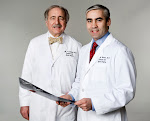
Rudolph F. Taddonio, M.D.
A practicing orthopedic surgeon since 1976, Dr. Taddonio has built a reputation as one of the most respected orthopedic surgeons for spinal deformity and complex reconstructive spine surgery in the metro New York/Hudson Valley and Connecticut area. On the forefront of advances in scoliosis treatment, he was one of forty spinal surgeons throughout the United States to refine ScoliScore, a groundbreaking genetic test designed to predict the risk of progression of scoliosis, an abnormal lateral curvature of the spine.
In addition to serving as Director of Scoliosis and Spinal Surgery at New York Medical College, he is Director of Orthopedics at Stamford Hospital. Dr. Taddonio is a clinical professor of orthopedic surgery and neurosurgery at New York Medical College and an assistant clinical professor of surgery at New York Presbyterian Hospital. Much in demand for his expertise, he has given more than 100 academic presentations around the world, and published dozens of journal articles and abstracts. He founded Scoliosis and Spinal Surgery in 1981.
A practicing orthopedic surgeon since 1976, Dr. Taddonio has built a reputation as one of the most respected orthopedic surgeons for spinal deformity and complex reconstructive spine surgery in the metro New York/Hudson Valley and Connecticut area. On the forefront of advances in scoliosis treatment, he was one of forty spinal surgeons throughout the United States to refine ScoliScore, a groundbreaking genetic test designed to predict the risk of progression of scoliosis, an abnormal lateral curvature of the spine.
Dr. Taddonio is a leader in state-of the art surgical techniques, including minimally invasive, motion sparing, and disc replacement surgery, and he is the first practitioner in the tri-state area to use image-guided (stereotactic) surgery. Stereotactic imaging improves the accuracy of spinal instrumentation, leading to safer surgery with decreased neurological complications.
In addition to serving as Director of Scoliosis and Spinal Surgery at New York Medical College, he is Director of Orthopedics at Stamford Hospital. Dr. Taddonio is a clinical professor of orthopedic surgery and neurosurgery at New York Medical College and an assistant clinical professor of surgery at New York Presbyterian Hospital. Much in demand for his expertise, he has given more than 100 academic presentations around the world, and published dozens of journal articles and abstracts. He founded Scoliosis and Spinal Surgery in 1981.

Krishn M. Sharma, M.D.
Dr. Sharma joined Scoliosis and Spinal Surgery in 2009, after having worked with Dr. Taddonio for the prior four years. He is an expert in spinal deformity and complex reconstructive spine surgery for children, teens and adults, and has broad experience in degenerative conditions and deformity correction as well as in the treatment of trauma-caused fractures. He practices state-of-the-art surgical techniques, including minimally invasive, image-guided (stereotactic), motion sparing and disc replacement surgery. Stereotactic imaging improves the accuracy of spinal instrumentation, leading to safer surgery with decreased neurological complications. Dr. Sharma is published in numerous scientific journals for the SRS and IMAST societies, and has been invited to present at national and international medical conferences.
Dr. Sharma received his medical degree from New York Medical College in Valhalla, New York, and trained at Union Memorial Hospital, The Johns Hopkins Hospital, and Shock Trauma Center at University of Maryland in Baltimore, MD. He served as chief resident of Orthopedic Surgery at Union Memorial Hospital in Baltimore, Maryland; and completed his Scoliosis and Spinal Surgery fellowship at Beth Israel Medical Center in New York City before entering private practice.
Dr. Sharma joined Scoliosis and Spinal Surgery in 2009, after having worked with Dr. Taddonio for the prior four years. He is an expert in spinal deformity and complex reconstructive spine surgery for children, teens and adults, and has broad experience in degenerative conditions and deformity correction as well as in the treatment of trauma-caused fractures. He practices state-of-the-art surgical techniques, including minimally invasive, image-guided (stereotactic), motion sparing and disc replacement surgery. Stereotactic imaging improves the accuracy of spinal instrumentation, leading to safer surgery with decreased neurological complications. Dr. Sharma is published in numerous scientific journals for the SRS and IMAST societies, and has been invited to present at national and international medical conferences.
Dr. Sharma received his medical degree from New York Medical College in Valhalla, New York, and trained at Union Memorial Hospital, The Johns Hopkins Hospital, and Shock Trauma Center at University of Maryland in Baltimore, MD. He served as chief resident of Orthopedic Surgery at Union Memorial Hospital in Baltimore, Maryland; and completed his Scoliosis and Spinal Surgery fellowship at Beth Israel Medical Center in New York City before entering private practice.






